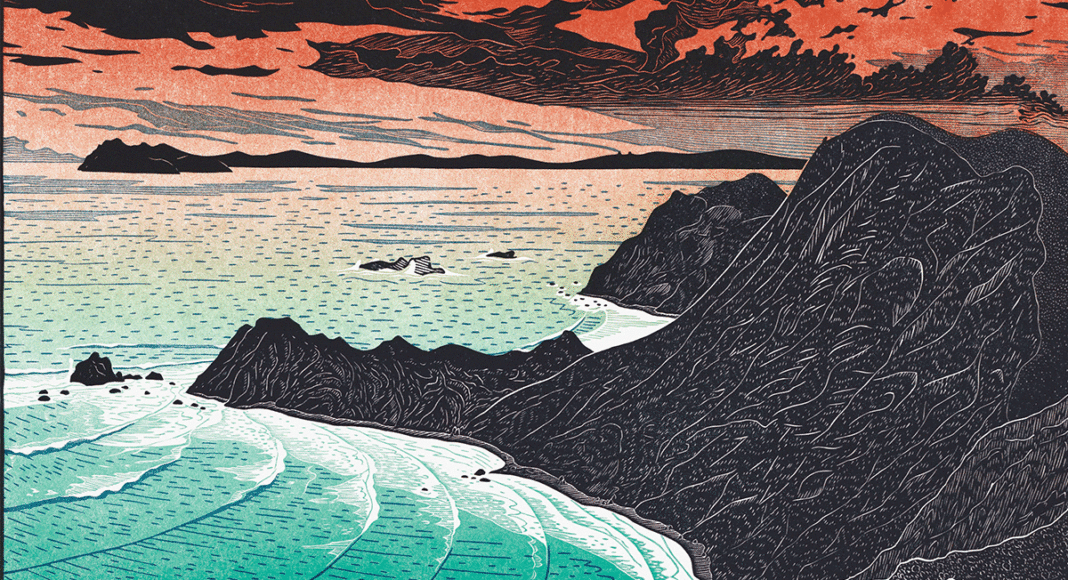Like many Californians, Tom Killion has topophilia. It’s defined as a strong sense of place, which often becomes mixed with a sense of cultural identity. Killion expresses his love of the California coast through centuries-old Japanese Ukiyo-ë style woodblock printing—think Hokusai’s “The Great Wave off Kanagawa.”
Last Friday, his newest exhibit, “California’s Wild Edge,” opened at the Museum of Art and History (MAH). Killion’s fascination with the California coastline is nothing new; he first published his illustrated book The Coast of California in the late ’70s. No stranger to Santa Cruz, he has been in and out of town since graduating from UCSC in 1975. In fact, judging from turnout for the opening event, he has made quite an impact.
In a room filled with elbow-rubbing, sandal-clad MAH members, his work evoked a cathartic familiarity, as evidenced by the number of people thrusting their faces near the glass boxes and framed prints in the hope of recapturing a distant memory. Statements like “I remember that beach” and “honey, it’s Wilder Creek” were heard frequently.
Killion begins his work by sketching his surroundings and taking notes. He then traces the image and begins carving the Japanese shina wood. The process hasn’t changed much in 1,000-plus years, and is just as laborious and difficult as you’d imagine.
Killion’s exhibit is a welcoming journey that you can begin in Southern California; from there, the room swings to the right and wraps around a corner to the Pacific Ocean, Big Sur and Point Lobos. Most visitors were instinctively drawn to what they knew: Natural Bridges, Davenport, Año Nuevo. The show continues on to Killion’s current Point Reyes locale before melding into the Northern California coastline finale.
Born and raised in Mill Valley, Killion’s obsession with the California landscape spans the entire coast, extending from below the Santa Monica Mountains to the North Coast’s picturesque beaches and beyond. An avid backpacker and hiker, he spends the majority of his time outside. He says he began printmaking almost accidentally when he broke his leg in a bicycle collision.
“I would have never become a printmaker if I hadn’t been hit by a car,” Killion says.
In school, he studied African history, eventually travelling to Africa where he worked in Sudan as administrator of a medical relief program in a camp for Ethiopian refugees. His time abroad inspired his 1990 book Walls: A Journey Across Three Continents, which was published five years before he returned to California and began teaching at San Francisco State University. He has since published multiple illustrated books on California’s landscapes.
Killion begins his work by sketching his surroundings and taking notes. He then traces the image and begins carving the Japanese shina wood. The process hasn’t changed much in 1,000-plus years, and is just as laborious and difficult as you’d imagine. Some prints require as many as 12 separate blocks, and that’s before the printing part has even started. If the print is in color, as the majority of his work is, each color requires its own block and run through the press.
Along with Killion’s work, the show includes poetry and excerpts from poets and writers like Jane Hirshfield, Jack Spicer, Jaime de Angulo, and Pulitzer winner Gary Snyder. Snyder and Killion are long-time friends and collaborators, and worked together on his California Coast book. The poetry is in both English and Spanish.
Part of the fun, Killion says, is that he never really knows how a print will turn out.
“There is always a surprise,” Killion says. “That’s the great joy of printmaking. It takes part of the construction of the image out of your hands and puts it out into this magical space.”
California’s Wild Edge is on exhibit until Sunday, April 22. Museum of Art and History 705 Front St., Santa Cruz. santacruzmah.org. General admission $10, free on First Fridays.













